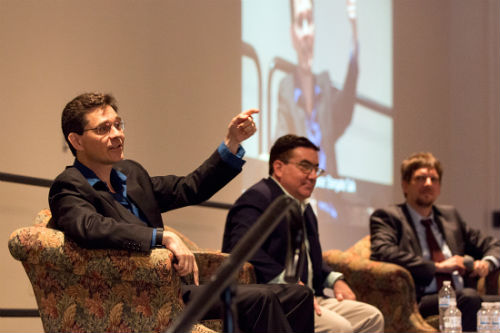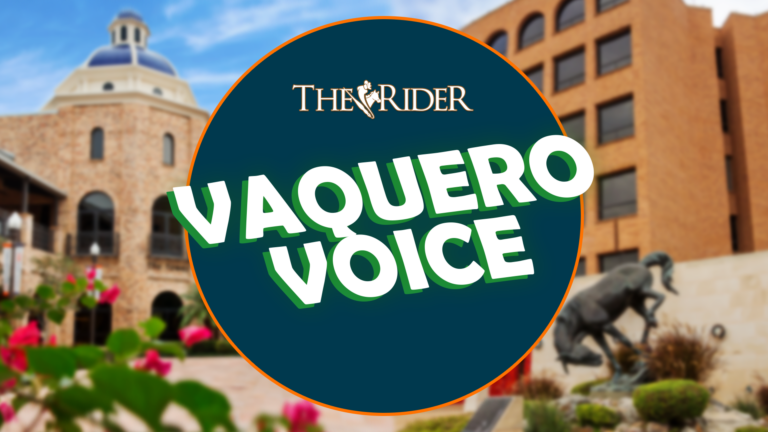
Fredrick Jenet (left), an associate professor of physics and director of the Center for Advanced Radio Astronomy, answers one of the questions asked by a member of the audience. Also shown are Sean Casey, co-founder and managing director of the Silicon Valley Space Center, and Volker Quetschke, an associate physics professor at UTRGV. Mario Gonzalez/The Rider
Brownsville middle and high schoolers asked space experts about reusable rockets, job opportunities, nuclear technology, antimatter, dark matter, space exploration and the SpaceX launchpad’s environmental impact during the recent STARGATE Talks.
The panel of experts consisted of keynote speaker Sean C. Casey, co-founder and managing director of the Silicon Valley Space Center; Fredrick Jenet, director of the Center for Advanced Radio Astronomy (CARA) of the University of Texas Rio Grande Valley; and Volker Quetschke, an associate professor in the Physics Department at UTRGV.
The forum, hosted by the nonprofit organization Project Space, took place last Tuesday at the Brownsville Event Center. Students were encouraged to ask questions about the concept of the New Space City, the Spacecraft Tracking and Astronomical Research into Giga-hertz Astrophysical Transient Emission (STARGATE) program and SpaceX.
SpaceX, which manufactures and launches advanced rockets and spacecraft, is in the process of building the first privately owned launch platform in the Boca Chica Beach area and expects to begin launching rockets in 2018.
“We want to start the discussion on envisioning the future of Brownsville,” Jenet told the more than 500 students gathered for the event. “This concept, I like to say, is ‘New Space City.’”
The concept refers to the new business opportunities that SpaceX and STARGATE will bring to the Valley.
STARGATE is an innovation program that is part of the partnership between CARA and SpaceX.
Asked if SpaceX was going to affect the environment at Boca Chica Beach, Jenet replied: “You are not allowed to develop anything for at least a 2-mile radius around that because you can’t have developments, you can’t have things there. So, what does that do? The entire environment around there is protected in that 2-mile radius. So, it turns out the environmental impact is minimal and it has also been shown that it is a boost to the environment.”
One student asked why Boca Chica Beach was picked for the SpaceX launchpad.
Jenet replied that it was because of its unique position near the equator, which gives them access to a larger range of orbit. NASA also considered Boca Chica for the same reason.
“Space is not something that’s happened in the past but it’s actually happening today, and it’s not happening for a very exclusive group but it’s actually a wide-ranging number of people can be involved in the growing space industry,” Casey said. “So, I think students should think that this is something that I can participate in and that I can be [a part] of.”
One of the main mandates of CARA is to work with school systems in order to give students the opportunity to be scientists.
The center also offers opportunities for students to join the STARGATE Academy, which is a three-week summer program focused on aerospace and rocket sciences. The program will be offered as dual enrollment, so students who attend will be able to receive college credit.
Christopher Wren, who is on the Android Framework team at Google, could not attend STARGATE Talks but conducted mock interviews for UTRGV students on the Brownsville campus.
Mock interviews are small examples of what it’s like to be interviewed for a job.
“Interview skills are something that people tend not to learn, and it is a skill,” Wren said. “And so, I can help people sort of identify holes in their skillset and give them ideas in what they can improve.”






